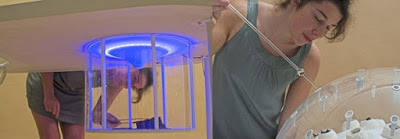The
problem of the disposal of plastics is a well known one, with plastics taking a
long time to bio-degrade even if they are described as biodegradable as this
video from DNEWS (Discovery News) YouTube channel about plastic eating worms
suggests.
So
what if you convert plastic into food? Turns out you can use special mushroom
grower called the Fungi Mutarium designed by Austrian designer Katharina Unger
to convert plastic into mushrooms as reported back in December 2014 in the
article “These
pollution-fighting mushrooms eat plastic, and you can eat them”, published
December 23, 2014 by Sonali Kohli, Quartz.
The
research was done by Austrian designer Katharina Unger in partnership with
Julia Kaisinger and Utrecht University and published back in December 2014, but
it's very relevant today as plastic pollution is on the rise as this video
suggests.
Austrian
designer Katharina Unger got her inspiration from research done by Yale
University in 2012 when they discovered a variety of mushroom (Pestalotiopsis microspora) than could
break down polyeurthane. Since then a race has been on to discover other fungi
that can feast on hydrocarbons in various forms, from oil to plastics.
Already,
researchers have found that a certain species of seaweed, the Dulce Algae
seaweed has been discovered by Oregon State University to taste like bacon when
fried as reported in my blog article
entitled “Oregon
State University discover Dulce Seaweed Algae taste like Bacon - How Dulce can
solve UNFAO's Meat Crisis in 2025 and also make Beer”.
The
latest has been the discovery by researchers at the Department of Civil and
Environmental Engineering at Stanford University as reported in the article “Plastic-eating
worms may offer solution to mounting waste, researchers discover”,
published September 30, 2015 by Rob Jordan, Physorg.
But
this previous published developement from the collaboration between Austrian
designer Katharina Unger in partnership with Julia Kaisinger and Utrecht
University is more practical as it means we can create edible mushrooms from
Plastic. so how does Fungi Mutarium mushroom grower actually work?
Katharina Unger Fungi
Mutarium - How Plastic munchin' Mushrooms can be a solution to Plastics in Jamaica
Austrian
designer Katharina Unger process for growing the Fungi Mutarium is not much
different from the use of growing rooms used by NOW (Network of Women for Food
Security), a mushroom co-operative located in central and northern Manchester,
Jamaica as described in my blog article
entitled “NOW
expands to capture JA$35 million Jamaican Edible Mushroom - How Jamaican can
grow and store Edible Mushrooms”.
Her
equiptment is just a bit more exotic as described in the article “A
mini farm that produces food from plastic-eating mushrooms”, published 22
December 2014 by Liz Stinton, Wired. First
the Fungi Mutarium Mushroom Grower is itself very space-age looking.
The plastic is masticated and zapped with
UV light to sterilize it and start the plastic on a process of breaking down so
that the Schizophyllum commune and Pleurotus ostreatus can eat it.
The
degrade plastic is then placed in Egg-shaped pods filed with agar-agar jelly,
which is normally used in laboratories to cultivate bacterium and fungi. The
diluted mycelium (roots) of Schizophyllum
commune and Pleurotus ostreatus
are then place into the Egg-shaped pods called FU's filled with agar-agar jelly
so that it can feast on the plastic.
In
a few months, the Schizophyllum commune and
Pleurotus ostreatus in the FU consume
all the plastic, while growing fluffy edible mushroom, filling the Fungi
Mutarium Mushroom Grower to capacity.
Admittedly
the process is very slow and can only make enough mushrooms for a small family.
But with the demand for mushrooms soaring in Developing and First World
countries, growing mushrooms from biodegradable and non-biodegradable plastics may
gradually be a solution to plastics.
It
may also be a way to deal with the problem of excess cooking oil leftover as
waste from restaurants in cities across the world as well as in Jamaica, aside
from making it into biofuel as described in my blog article entitled
“UWI
and YCWJ team up to Recycle Waste Cooking Oil - How to make National Bio-Diesel
Production from Waste Cooking Oil”.
They
are quite safe, as plastic, despite being manmade, is an organic compound, just
that it’s molecular structure is too difficult for plants to ingest and convert
into food via photosynthesis or other means as fungi like mushrooms can do.
By
degrading the plastic into a form that the plants and fungi, can consume,
edible mushrooms can be grown. This is potentially a solution to the problem of
Plastic pollution and in the process, allowing Jamaica to tap into the US$35
million imported edible mushroom Industry that’s blooming in Jamaica.
Especially
when you consider how easy they are to grown and the use of Agricultural towers
as described in my blog article entitled
“IGES
Canada Ltd and Vertical Agricultural Towers - How Vertical Hydroponic Aquaponic
Greenhouses can make low cost Organic foods” are used to make the process
of growing the mushrooms more efficient.
So
edible Mushrooms from plastic, anyone?




No comments:
Post a Comment
Please register and leave you comments. For contact, leave an email or phone number and I'll be sure to get back to you.